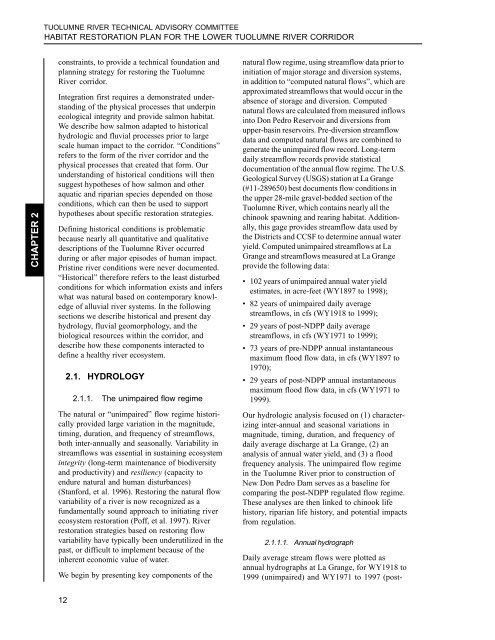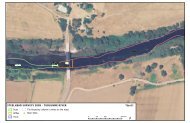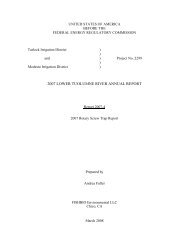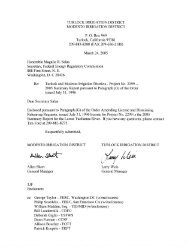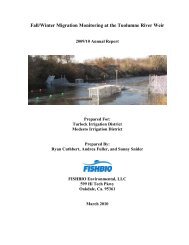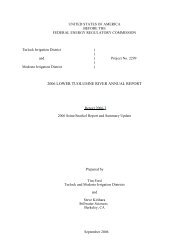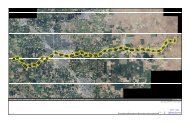Tuolumne River Report - U.S. Fish and Wildlife Service
Tuolumne River Report - U.S. Fish and Wildlife Service
Tuolumne River Report - U.S. Fish and Wildlife Service
You also want an ePaper? Increase the reach of your titles
YUMPU automatically turns print PDFs into web optimized ePapers that Google loves.
TUOLUMNE RIVER TECHNICAL ADVISORY COMMITTEEHABITAT RESTORATION PLAN FOR THE LOWER TUOLUMNE RIVER CORRIDORCHAPTER 2constraints, to provide a technical foundation <strong>and</strong>planning strategy for restoring the <strong>Tuolumne</strong><strong>River</strong> corridor.Integration first requires a demonstrated underst<strong>and</strong>ingof the physical processes that underpinecological integrity <strong>and</strong> provide salmon habitat.We describe how salmon adapted to historicalhydrologic <strong>and</strong> fluvial processes prior to largescale human impact to the corridor. “Conditions”refers to the form of the river corridor <strong>and</strong> thephysical processes that created that form. Ourunderst<strong>and</strong>ing of historical conditions will thensuggest hypotheses of how salmon <strong>and</strong> otheraquatic <strong>and</strong> riparian species depended on thoseconditions, which can then be used to supporthypotheses about specific restoration strategies.Defining historical conditions is problematicbecause nearly all quantitative <strong>and</strong> qualitativedescriptions of the <strong>Tuolumne</strong> <strong>River</strong> occurredduring or after major episodes of human impact.Pristine river conditions were never documented.“Historical” therefore refers to the least disturbedconditions for which information exists <strong>and</strong> inferswhat was natural based on contemporary knowledgeof alluvial river systems. In the followingsections we describe historical <strong>and</strong> present dayhydrology, fluvial geomorphology, <strong>and</strong> thebiological resources within the corridor, <strong>and</strong>describe how these components interacted todefine a healthy river ecosystem.2.1. HYDROLOGY2.1.1. The unimpaired flow regimeThe natural or “unimpaired” flow regime historicallyprovided large variation in the magnitude,timing, duration, <strong>and</strong> frequency of streamflows,both inter-annually <strong>and</strong> seasonally. Variability instreamflows was essential in sustaining ecosystemintegrity (long-term maintenance of biodiversity<strong>and</strong> productivity) <strong>and</strong> resiliency (capacity toendure natural <strong>and</strong> human disturbances)(Stanford, et al. 1996). Restoring the natural flowvariability of a river is now recognized as afundamentally sound approach to initiating riverecosystem restoration (Poff, et al. 1997). <strong>River</strong>restoration strategies based on restoring flowvariability have typically been underutilized in thepast, or difficult to implement because of theinherent economic value of water.We begin by presenting key components of thenatural flow regime, using streamflow data prior toinitiation of major storage <strong>and</strong> diversion systems,in addition to “computed natural flows”, which areapproximated streamflows that would occur in theabsence of storage <strong>and</strong> diversion. Computednatural flows are calculated from measured inflowsinto Don Pedro Reservoir <strong>and</strong> diversions fromupper-basin reservoirs. Pre-diversion streamflowdata <strong>and</strong> computed natural flows are combined togenerate the unimpaired flow record. Long-termdaily streamflow records provide statisticaldocumentation of the annual flow regime. The U.S.Geological Survey (USGS) station at La Grange(#11-289650) best documents flow conditions inthe upper 28-mile gravel-bedded section of the<strong>Tuolumne</strong> <strong>River</strong>, which contains nearly all thechinook spawning <strong>and</strong> rearing habitat. Additionally,this gage provides streamflow data used bythe Districts <strong>and</strong> CCSF to determine annual wateryield. Computed unimpaired streamflows at LaGrange <strong>and</strong> streamflows measured at La Grangeprovide the following data:• 102 years of unimpaired annual water yieldestimates, in acre-feet (WY1897 to 1998);• 82 years of unimpaired daily averagestreamflows, in cfs (WY1918 to 1999);• 29 years of post-NDPP daily averagestreamflows, in cfs (WY1971 to 1999);• 73 years of pre-NDPP annual instantaneousmaximum flood flow data, in cfs (WY1897 to1970);• 29 years of post-NDPP annual instantaneousmaximum flood flow data, in cfs (WY1971 to1999).Our hydrologic analysis focused on (1) characterizinginter-annual <strong>and</strong> seasonal variations inmagnitude, timing, duration, <strong>and</strong> frequency ofdaily average discharge at La Grange, (2) ananalysis of annual water yield, <strong>and</strong> (3) a floodfrequency analysis. The unimpaired flow regimein the <strong>Tuolumne</strong> <strong>River</strong> prior to construction ofNew Don Pedro Dam serves as a baseline forcomparing the post-NDPP regulated flow regime.These analyses are then linked to chinook lifehistory, riparian life history, <strong>and</strong> potential impactsfrom regulation.2.1.1.1. Annual hydrographDaily average stream flows were plotted asannual hydrographs at La Grange, for WY1918 to1999 (unimpaired) <strong>and</strong> WY1971 to 1997 (post-12


